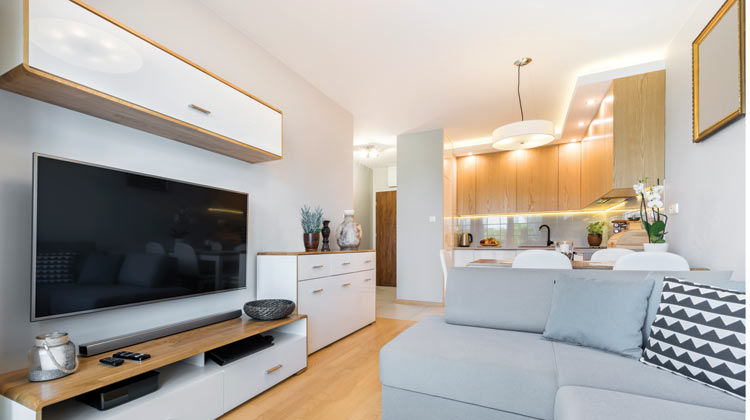by Katherine Salant
Despite its importance in the household, the TV is usually purchased and plunked in among other furniture without much thought about its placement for easy watching or its effect on other activities in the space it occupies.
Planning and designing a new house, however, affords the opportunity to rethink this important artifact of daily life —where to put it, whether to get a supersized set with a jazzy built-in sound system or not, how to conceal the TV when not in use, and even, do we really need this many sets in one house?
Though “a good place for watching TV” is rarely on her clients’ “must have list,” architect Sarah Susanka always discusses television viewing habits with them and factors these in when designing a new house.
Most households have a TV in the family room, but “TV viewing styles” vary from household to household, Susanka said.
In some families, parents or older children will partake in other activities such as homework or surfing on a tablet while watching TV and thus watch it somewhat distractedly. In others, one or two family members prefer to watch TV in a more focused way without interruption. When this is the case, Susanka suggests taking the TV out of the multi-purpose family room and creating an alcove or separate room for it in the new house.
If the TV stays in the family room, the family may still need the alcove or separate room for activities that require concentration and can’t be done if the TV is on all the time, such as homework, Susanka said.
Another TV question Susanka discusses with clients is the size of the TV in the new family room. Many people building a new house want to get a large 50-inch or even larger size set, large enough to “recreate the ‘willful suspension of disbelief’ that you experience in a movie theatre,” said automation consultant David Wogsland, who designs home entertainment centres.
Before making any decisions about a larger TV, make sure that the room you plan to put it in is big enough, since a large screen TV requires a large viewing space, Wogsland said. Most people want to put the big TV in the family room, but with all the other things that they also want to put there, it may work better in another room.
As a general rule of thumb, you need to sit back a distance at least twice the diagonal dimension of the TV screen. If the screen is 50 inches, you need to sit back at least 100 inches or about 8 1/2 feet. This distance will be comfortable “if you’re the type who wants to feel like you’re inside the movie and like to sit very close to the screen in a movie theatre,” he said. “If you’re more of a spectator-type viewer and tend to sit farther back in a movie theater, you may want to sit 10 to 12 feet back.”
If you decide to get the large screen TV, Wogsland suggests getting a surround sound speaker system installed when your house is built. But he cautions that this will not work well in every space. If the ceiling is two-storeys high, for example, the surround sound “will not deliver the best audio quality.”
Certain exposures can also affect viewing enjoyment, Wogsland noted. If the family room has many south-facing windows, there will be too much sunlight to see the screen and window treatments will be necessary.
Should the family room of your new house have a high ceiling or lots of glass and sunlight, you should move the TV and sound system to another room, Wogsland advised. His favourite spot is the basement because it is away from the general hubbub of family activities and sunlight streaming through windows is not a problem.
A TV in the master bedroom is not unusual, and not just for night time viewing. Surprisingly, Susanka said, some families hang out here all day, especially those with young children. Most people put a smaller set here.
If you want a large 50-inch one that you can watch from the bed, this type comes with its own base that you must raise up, Wogsland noted. “Otherwise your toes will be in the way of the screen.”
A TV in the bathroom is another common request, Susanka said. Most people want to be able to see it from a large soaking tub, but this can be tricky because most building codes require that the TV be at least five feet from the tub.
If the wall at one end of the tub is next to a closet, Wogsland has installed a TV on a shelf in the closet behind one-way mirror glass. He made small holes in the glass to let the sound pass through and the homeowner operates it in the bathroom with a remote. When the set is on, you can see it through the glass; when it’s off, you just see mirror, he said.
Some bathtub TV viewing calls for ingenious solutions. Susanka recalled that the only way to make this possible in one house was to place the set so that it was reflected in a mirror which could be seen from the tub.
— Inman News Features.



